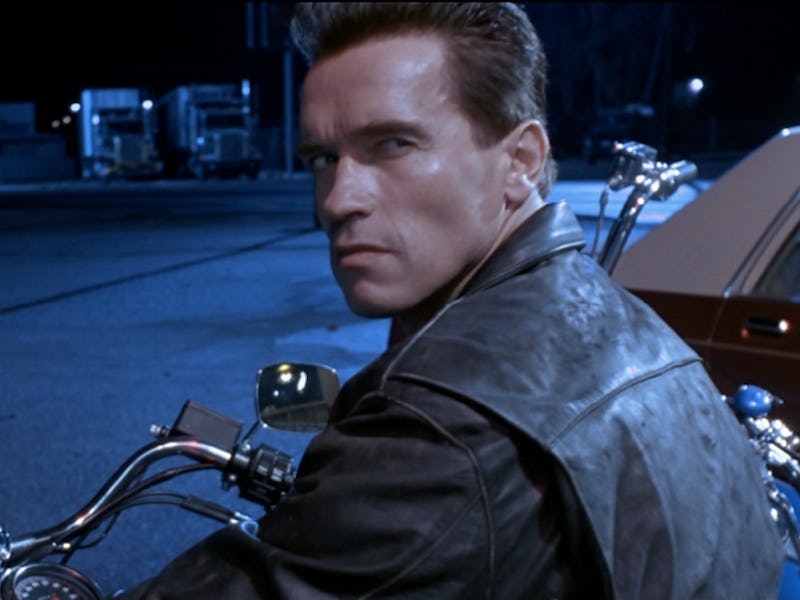28 Years Later, 'Terminator 2' Is Still the Best Sequel Ever
On the anniversary of the release of 'Judgment Day,' we take a look at how flipping the story on its head made James Cameron's follow-up so essential.

Late in the movie Terminator 2: Judgment Day, Sarah Connor (Linda Hamilton) carves the words “No Fate” into a wooden table in the middle of the desert compound where she, her son John (Edward Furlong), and their powerful cyborg friend (Arnold Schwarzenegger) are hiding out. Soon, she storms off in a last ditch effort to kill a man who is inadvertently responsible for the apocalypse, leaving John and the designated T-800 robot to ponder what the graffiti meant.
“No fate but what we make,” John says. “My father told her this. I made him memorize it up in the future as a message to her.” The irony is, had another version of the Terminator succeeded in its mission year earlier, there would be no father, no John, and no Sarah. When writer/director James Cameron put together this scene two decades ago, he had no idea what the future would hold, but at least in his fictional world, he could control it. Now, 25 years later, Terminator 2 remains a sequel above the rest.
By the time T2 was released in 1991, Cameron had already proven himself as a filmmaker. The original 1984 Terminator film became his breakout hit, and then Cameron decided to take on the potentially ruinous task of making a sequel to director Ridley Scott’s film Alien. Using the opportunity as a proving ground, Cameron’s film upended Scott’s more horror-focused first installment. Gone were the shadowy stretches of space-tinged terror. Instead, Cameron added an array of acid-blooded aliens and a whole doomed squadron of military grunts and made a war movie. It also featured one of the most beloved female protagonists in cinema history.
With Aliens, Cameron next set his sights on delivering another blockbuster. While not the same critical and financial success as Aliens, 1989’s The Abyss still demonstrated Cameron’s ability to make a movie all his own despite enormously legendary production problems. Cameron, perhaps more than any other living filmmaker, has a doomed sense of hubris that allows him to create seemingly insane situations like shooting an entire movie underwater, but also leave room for a work ethic that produced some of the most popular movies ever made. What followed, was among the best ever made.
Like Aliens before it, Cameron’s audacious approach to Terminator 2 is what defines it the most. Not a simple rehash of the original — a problem that befalls far too many cinematic follow-ups — or the relatively new phenomenon of the soft reboot, which simply repackages regurgitated iconography back at the audience, the movie is a sequel insofar as it involves characters from the first movie but is basically nothing like it. He took the same semi-courageous leap in changing the feel of a franchise with Aliens, but this time he made it his own.
Superficially yes, there are robots sent back in time, references to an apocalyptic future, a woman in trouble, and Arnold Schwarzenegger spouting off memorable one-liners. But like Arnold, Cameron said “Hasta la vista baby” to the rulebook with his sequel and tinkered with the basic formula that made the first Terminator movie work; namely that the relatively charmless Schwarzenegger was an evil robotic killing machine. Here, due to the future freedom fighters led by John Connor reprogramming a T-800, Schwarzenegger’s ruthless villain suddenly became the heroic savior. Also, Hamilton’s damsel in distress in the first movie, who was described in the original Terminator script as someone who “doesn’t stop the party when she walks in, but you’d like to get to know her,” and that “her vulnerable quality masks a strength even she doesn’t know exists,” seemed to more than prove the latter part of that description. The 19-year-old innocent Sarah was now turned into a battle-hardened warrior like a more radical and semi-insane version of the Ripley character he developed in Aliens.
By completely rewriting the tenets of The Terminator for his sequel, Cameron risked making it something that didn’t resemble a Terminator movie. It was perhaps advantageous to the story that the sequel was technically developed for the original, as the dual future robots fighting in the past was abandoned as too costly to create in 1984. But developing that idea for the sequel made a genuine continuation of the storyline that still created its own brand new iconography.
It was, ironically enough, original unto itself, and by being different it became the Platonic ideal of the series. The remaining Terminator movies have been trying to keep up ever since, trying to come up with the same type of ingenious rug-pull that Cameron pulled off but never making it work. There’s no cinematic fate but what James Cameron makes it, and he made what had to be the best sequel ever made.